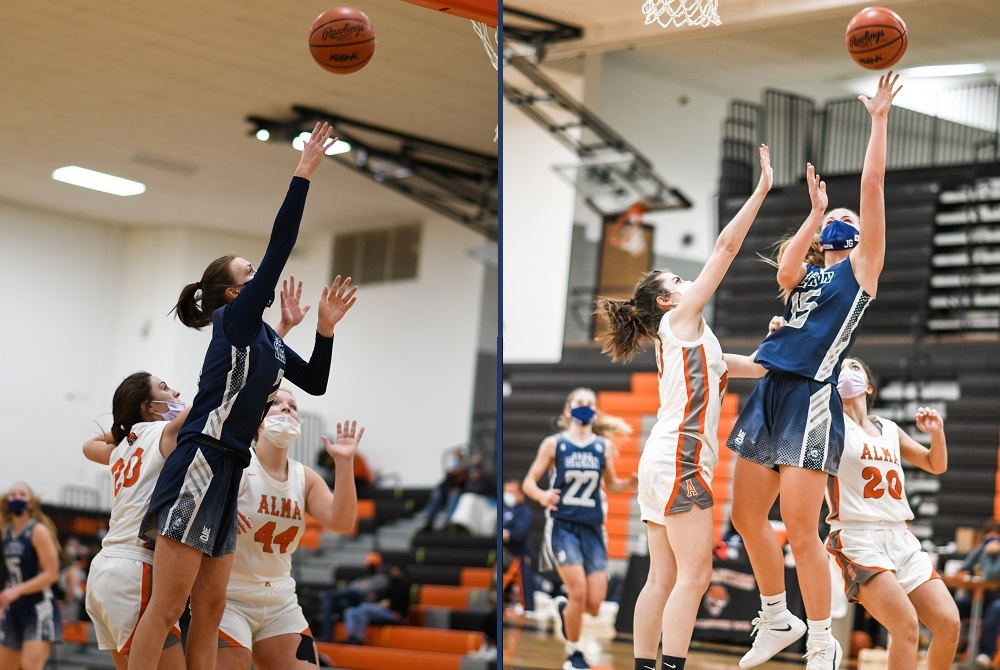
1,000-Point Pair Pacing Another John Glenn Contender
By
Paul Costanzo
Special for MHSAA.com
March 3, 2021
Abi Tarrant knew how close Carly McCrum was to 1,000 career points and wanted to make sure her Bay City John Glenn teammate’s accomplishment was celebrated.
 On Feb. 17, when McCrum achieved the milestone in a victory against Alma, the John Glenn fans in attendance cheered the moment while waving homemade signs, which they had been carrying thanks in large part to an effort spearheaded by Tarrant.
On Feb. 17, when McCrum achieved the milestone in a victory against Alma, the John Glenn fans in attendance cheered the moment while waving homemade signs, which they had been carrying thanks in large part to an effort spearheaded by Tarrant.
“Last year, I broke the (school career) rebound record, and all of the student section, everybody made posters, and it was a huge moment for me,” Tarrant said. “I knew she was getting her 1,000 points that week, so I wanted her to have the same type of environment. Even though the student section wasn’t there, she could still have that kind of energy from the crowd when she hit it.”
It was only after the celebration for McCrum subsided that Tarrant realized just how close she was to the same milestone: 16 points.
“I knew exactly where she was because I had been planning the poster thing,” Tarrant said. “(One thousand points) kind of snuck up on me. I didn’t know I was that close to her. But in the game it happened, I knew.”
Tarrant achieved her own milestone the next time out, a John Glenn victory on Feb. 19 against Birch Run, giving the Bobcats a pair of 1,000-point scorers in the same class.
McCrum now sits at 1,053 career points and Tarrant has 1,046 as they have led the Bobcats to a 7-1 start to the season and a top-five ranking in The Associated Press Division 2 poll. Their lone loss came in double overtime against Frankenmuth, another top-five team.
 “I just thought it was a really cool experience,” McCrum said. “We’ve both been on varsity since our freshmen year, and we’ve played with each other on the same travel team, so it was very cool that we hit it in the same week. We both feel like this team is really special, and our goal is to win a state championship.”
“I just thought it was a really cool experience,” McCrum said. “We’ve both been on varsity since our freshmen year, and we’ve played with each other on the same travel team, so it was very cool that we hit it in the same week. We both feel like this team is really special, and our goal is to win a state championship.”
Tarrant and McCrum became the seventh and eighth players in school history to hit the 1,000-point mark. It’s the second time John Glenn has had classmates reach the milestone, joining 2016 graduates Jenai LaPorte (1,547 points) and Cassidy Boensch (1,403). Boensch did play her first two seasons at Au Gres-Sims.
“I’ve been really spoiled,” John Glenn coach Cory Snider said. “Three of those 1,000-point scorers (LaPorte, Boensch and 2017 graduate Kalle Martinez) were all on the same team. The five kids I’ve had (reach 1,000 points) have all been on the same teams, so that’s a really unique situation. You don’t hear of that a whole lot. They make me look way smarter than I am.”
McCrum and Tarrant are both four-year varsity players for Snider, and for McCrum, it was clear early on that she would become another of the school’s great scorers. She was the team’s leading scorer during her freshman (14 points per game) and sophomore (14.2) seasons.
“Carly has been the steady, calm influence on our team for four years,” Snider said. “It’s pretty incredible to be able to come in as a freshman and give us (14.2) points per game when she was (the focus) on everybody’s scouting report her freshman year.”
McCrum said it was a role she was comfortable with, as she had taken it on through middle school as a travel player.
“It wasn’t something really new for me,” said McCrum, a 5-foot-10 guard who has signed with Ferris State. “Probably my freshman year, I did feel some pressure and it got in my head, but it’s gotten a lot better, and I’ve gotten more comfortable with that.”
While she’s thrived in that role, and has established herself as a strong outside shooter, McCrum would rather be the one setting up teammates.
“She has such a high basketball IQ,” Snider said. “She’s more of a true playmaker than a natural scorer. She has a super high basketball IQ and loves to find the open player. She enjoys making an assist as much as she enjoys scoring a basket.”
 While McCrum was filling up the scoresheet early on, Tarrant had to find a different way to make an impact for the Bobcats. Despite her size – she's 5-7 now – that wound up being rebounding.
While McCrum was filling up the scoresheet early on, Tarrant had to find a different way to make an impact for the Bobcats. Despite her size – she's 5-7 now – that wound up being rebounding.
“Freshman year, I was just kind of in the right place at the right time, and I think that’s a lot of it,” said Tarrant, who is committed to Hope College. “A lot of those are rebounds that the posts don’t want to get, like running out of bounds. I would sneak up behind people to get them – I just always find myself somewhere near it. My dad told me that if you’re not going to score, then you have to do something. I guess I just picked that.”
Tarrant has done that better than anyone in school history, racking up 732 career rebounds.
“She just played with such a high motor, and she had such a desire to be really good,” Snider said. “Her growth as a player has been incredible from her freshman year to now as a senior. It’s more growth than I’ve seen from any other player. It’s unbelievable.”
Tarrant’s scoring picked up in a big way a year ago, as she averaged 19.4 points per game, setting a junior-year record for points at John Glenn.
“I think we molded more as a team,” Tarrant said. “We started playing a lot better together. At first, I think it was hard. Freshman year, Carly was the best player through and through, then sophomore year I stepped up my game a little bit. Junior year, we figured out how our games complement each other. This year, we’re playing amazing together.”
With a strong supporting cast surrounding them, McCrum and Tarrant hope to take John Glenn back to the heights it reached not long ago. The Bobcats were a Class B semifinalist in 2016 but have had their season ended by Freeland every year since, including in the District Final the past three seasons.
But they feel this could be the year they add some team trophies to the individual successes they’ve been able to rack up.
“It would mean a lot,” McCrum said. “Abi and I have been on the same team since freshman year. Some of the girls, we have been together since sophomore year. We’ve all been together for a long time. First of all, we want to win Districts. We’ve lost three years in a row to Freeland. I think it would be so awesome. We’ve all been together for so long, and we’ve always talked about going so far.”
 Paul Costanzo served as a sportswriter at The Port Huron Times Herald from 2006-15, including three years as lead sportswriter, and prior to that as sports editor at the Hillsdale Daily News from 2005-06. He can be reached at [email protected] with story ideas for Genesee, Lapeer, St. Clair, Sanilac, Huron, Tuscola, Saginaw, Bay, Arenac, Midland and Gladwin counties.
Paul Costanzo served as a sportswriter at The Port Huron Times Herald from 2006-15, including three years as lead sportswriter, and prior to that as sports editor at the Hillsdale Daily News from 2005-06. He can be reached at [email protected] with story ideas for Genesee, Lapeer, St. Clair, Sanilac, Huron, Tuscola, Saginaw, Bay, Arenac, Midland and Gladwin counties.
PHOTOS: (Top) Bay City John Glenn’s Abi Tarrant, left, and Carly McCrum make strong moves to the hoop against Alma this season. (Middle) Tarrant focuses for a free throw. (Below) McCrum maintains possession against Freeland. (Photos by Jodi Stopyak.)

Soccer, Hoops Next to Seed Using MPR
August 6, 2019
By Rob Kaminski
MHSAA benchmarks editor
As the topic of seeding for MHSAA Tournaments continues to swirl in the air of numerous committee meetings on an annual basis, one of the primary concerns continues to focus on the simple question: “How?”
The MHSAA for years has been working behind the scenes on potential formulas which could best be used as a standardized tool to assist in measuring strengths of teams in a given sport.
This spring, the MHSAA introduced the Michigan Power Rating in the sport of Boys Lacrosse. The Representative Council approved limited seeding beginning in 2019-20 for girls and boys soccer and girls and boys basketball, and MPR will be the metric to determine which two teams must be seeded on opposite sides of District brackets in those sports.
“The boys lacrosse tournament has been seeded since it was added as an MHSAA-sponsored sport in 2005. The seeding is done by committee based on several criteria, one of which was statewide power rankings generated by a third-party website. In the Fall of 2018, that website ceased operation – it was the perfect opportunity for the MHSAA to develop its own data-driven, purely objective ratings system and incorporate that data into the seeding criteria,” said Cole Malatinsky, administrative assistant for the sport.
“The benefits of the new MPR system have been already mentioned – it is MHSAA controlled, simple, objective, and transparent, and it can be used by other MHSAA sports in the future.”
MPR is a computer rating formula similar to the popular RPI rating. MPR provides a way to measure a team’s strength relative to other teams, based on games played against other MHSAA tournament teams, largely on the strength of their opponents’ schedules. MPR is purely objective using only the game results listed on MHSAA.com – there is no subjective human element.
What is the basic MPR formula?
MPR is calculated using wins, losses and ties for games played between teams entered into the MHSAA tournament. The final MPR number is 25% of the team's winning percentage, plus 50% of its opponent's winning percentage, plus 25% of its opponent's opponent's winning percentage.
MPR = (.25 x W%) + (.50 x OW%) + (.25 x OOW%)
The MPR formula can be applied easily to other MHSAA team sports.
What game data is included in the formula? What game data is not?
MPR looks only at results between opponents entered into the MHSAA postseason tournament. Wins, losses and ties in multi-team shortened game tournaments (lacrosse, soccer) also count. Forfeits also are counted as wins and losses.
MPR does not use the specific scores of a game or the margin of victory in a game. The location of a game is not included in the MPR formula, and the formula weighs results at the beginning of the season the same as results at the end of the season. Scrimmages are not included.
Why use the MPR formula?
Different rating systems have been used in the past or have been recommended to the MHSAA. We wanted to have a rating system where the data was controlled and stored in house and could be used for any sport featuring head-to-head competitions.
With its own rating system the MHSAA also can control the different components of the formula, thus keeping the tenets of scholastic competition at the forefront (like not including margin of victory in the formula). Finally, by listing all scores and team schedules online, as well as showing the MPR calculator on each team schedule page, the ratings are transparent and can be replicated easily.
CALCULATING MPR
What are the detailed components of the MPR formula?
You need three numbers to calculate your MPR: winning percentage (W%), opponent’s winning percentage (OW%) and opponent’s opponent’s winning percentage (OOW%).
How do you calculate winning percentage (W%)?
Divide the number of wins by the number of total games played. A tie is worth half a win. For MPR purposes, find the winning percentage against all teams that will play in the MHSAA tournament (MPR W%). Games played against out-of-state teams, varsity “B” teams, junior varsity teams, non-school club teams, and any other non-MHSAA tournament participants should not be included when calculating winning percentage. W% should be an easy number to calculate.
How do you calculate opponent’s winning percentage (OW%)?
Average the winning percentages of a team's opponents. When calculating the winning percentage of a specific opponent, use the opponents "Adjusted Winning Percentage" (ADJ W%). Adjusted winning percentage eliminates all games the team played against that opponent (as well as its games against non-MHSAA opponents).
For instance, if the team beat an opponent with an overall record of 4-1, use a record of 4-0 (1.000) for that opponent. If the team lost to an opponent, use a record of 3-1 (.750). Find the ADJ W% for all opponents, and then take the average. If a team plays an opponent team twice, that opponent’s ADJ W% will be counted twice.
OW% is not calculated via the combined record of the opponents; instead take the average of all opponent’s winning percentages.
How do you calculate opponent’s opponent’s winning percentage (OOW%)?
Use the same process described above, except calculated for the opponents of a team's opponents. This number is much harder to manually calculate, so the OW% for every team is listed on the MPR page of the MHSAA website.
Again, simply take the average of all opponent’s OW%.
How often is MPR calculated?
MPR is calculated about every five minutes. Enter a score and a minutes later the team MPR and the MPR of all the team's opponents will update.
How much will my MPR change throughout the season?
You will see wild MPR swings in the beginning of the season, but after about 10 games played your MPR will start to level out. At 20 games played you will see very little movement with each additional game played.
My score is missing. How can it be added?
This is a crowd-sourced system. Any registered user of MHSAA.com can add a missing score. ADs, coaches, parents, students and fans all can login and enter a score for any game.
What are some common errors when calculating MPR?
When calculating your team’s winning percentage, only include games against MHSAA-tournament teams. When calculating your opponent’s winning percentage, don’t include the games they played against you. When calculating ties, count the game as a half-win and half-loss.
What happens if a game is cancelled?
Because the MPR system works off of averages, it will not make a difference in the final MPR if a game cannot be rescheduled. It would not penalize, nor benefit, any team involved in that scenario.
USING THE WEBSITE
Where can I find game scores?
A list of statewide scores for all sports can be found in the MHSAA Score Center. To find a schedule for any team click on “Schools & Schedules” in the top navigation bar, search for the school, then once on the school page click the sport. You can also see a list of all schools (with links to schedules), on the statewide MPR list.
“We continue to have great success in score reporting for varsity boys lacrosse contests. While we state that schedule submission and score reporting to MHSAA.com are required, athletic directors and coaches understand that in order for MPR data to be accurate, we need consistent and accurate score reporting,” said Malatinsky. “MHSAA.com is now the primary site for high school boys lacrosse schedules, results and ratings in the state.”
How should I use the statewide list of teams and MPR?
Linked to the boys soccer page (and eventually to be added for both basketball pages and girls soccer) is a statewide listing of all Michigan Power Ratings (MPR) for teams entered into the MHSAA postseason tournament for that sport. Linked on the MPR page is an explanation of the District draw formula, describing when and how teams will be placed on the bracket.
The MPR data updates every five minutes. Click on the column headings to sort the data. You also can use the drop-down menu to show teams in one Division, or type a District number in the box to filter teams for that District (Region for boys lacrosse).
You also can click on any school name to go to its schedule page.
How do I read the school schedule page?
The schedule at the top of the page shows the date and opponent for all scheduled games, and results for games already played. If results are missing, click “Submit Score” to add a game score.
Below the game schedule is the MPR Calculator. The calculator is split into three sections. The first section shows the three MPR component scores for the team, as well as the team’s current MPR score. The second section shows the MPR information for the team’s opponents – specifically, for the opponents the team already has played (actually, for games where scores have been submitted). Only these games are included in the MPR calculation.
The third section highlights future opponents. The MPR data for future opponents are not used in the MPR calculation for the team.
PHOTO: East Kentwood and Ann Arbor Skyline play for last season’s Division 1 boys soccer championship.

